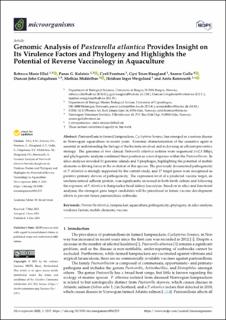| dc.contributor.author | Ellul, Rebecca Marie | |
| dc.contributor.author | Kalatzis, Panos G. | |
| dc.contributor.author | Frantzen, Cyril Alexander | |
| dc.contributor.author | Haugland, Gyri Teien | |
| dc.contributor.author | Gulla, Snorre | |
| dc.contributor.author | Colquhoun, Duncan John | |
| dc.contributor.author | Middelboe, Mathias | |
| dc.contributor.author | Wergeland, Heidrun Inger | |
| dc.contributor.author | Rønneseth, Anita | |
| dc.date.accessioned | 2022-04-11T11:50:25Z | |
| dc.date.available | 2022-04-11T11:50:25Z | |
| dc.date.created | 2021-06-28T13:32:00Z | |
| dc.date.issued | 2021 | |
| dc.identifier.issn | 2076-2607 | |
| dc.identifier.uri | https://hdl.handle.net/11250/2990931 | |
| dc.description.abstract | Pasteurellosis in farmed lumpsuckers, Cyclopterus lumpus, has emerged as a serious disease in Norwegian aquaculture in recent years. Genomic characterization of the causative agent is essential in understanding the biology of the bacteria involved and in devising an efficient preventive strategy. The genomes of two clinical Pasteurella atlantica isolates were sequenced (≈2.3 Mbp), and phylogenetic analysis confirmed their position as a novel species within the Pasteurellaceae. In silico analyses revealed 11 genomic islands and 5 prophages, highlighting the potential of mobile elements as driving forces in the evolution of this species. The previously documented pathogenicity of P. atlantica is strongly supported by the current study, and 17 target genes were recognized as putative primary drivers of pathogenicity. The expression level of a predicted vaccine target, an uncharacterized adhesin protein, was significantly increased in both broth culture and following the exposure of P. atlantica to lumpsucker head kidney leucocytes. Based on in silico and functional analyses, the strongest gene target candidates will be prioritized in future vaccine development efforts to prevent future pasteurellosis outbreaks. | en_US |
| dc.language.iso | eng | en_US |
| dc.publisher | MDPI | en_US |
| dc.rights | Navngivelse 4.0 Internasjonal | * |
| dc.rights.uri | http://creativecommons.org/licenses/by/4.0/deed.no | * |
| dc.title | Genomic analysis of pasteurella atlantica provides insight on its virulence factors and phylogeny and highlights the potential of reverse vaccinology in aquaculture | en_US |
| dc.type | Journal article | en_US |
| dc.type | Peer reviewed | en_US |
| dc.description.version | publishedVersion | en_US |
| dc.rights.holder | Copyright 2021 The Author(s) | en_US |
| dc.source.articlenumber | 1215 | en_US |
| cristin.ispublished | true | |
| cristin.fulltext | original | |
| cristin.qualitycode | 1 | |
| dc.identifier.doi | 10.3390/microorganisms9061215 | |
| dc.identifier.cristin | 1918929 | |
| dc.source.journal | Microorganisms | en_US |
| dc.identifier.citation | Microorganisms. 2021, 9 (6), 1215. | en_US |
| dc.source.volume | 9 | en_US |
| dc.source.issue | 6 | en_US |

